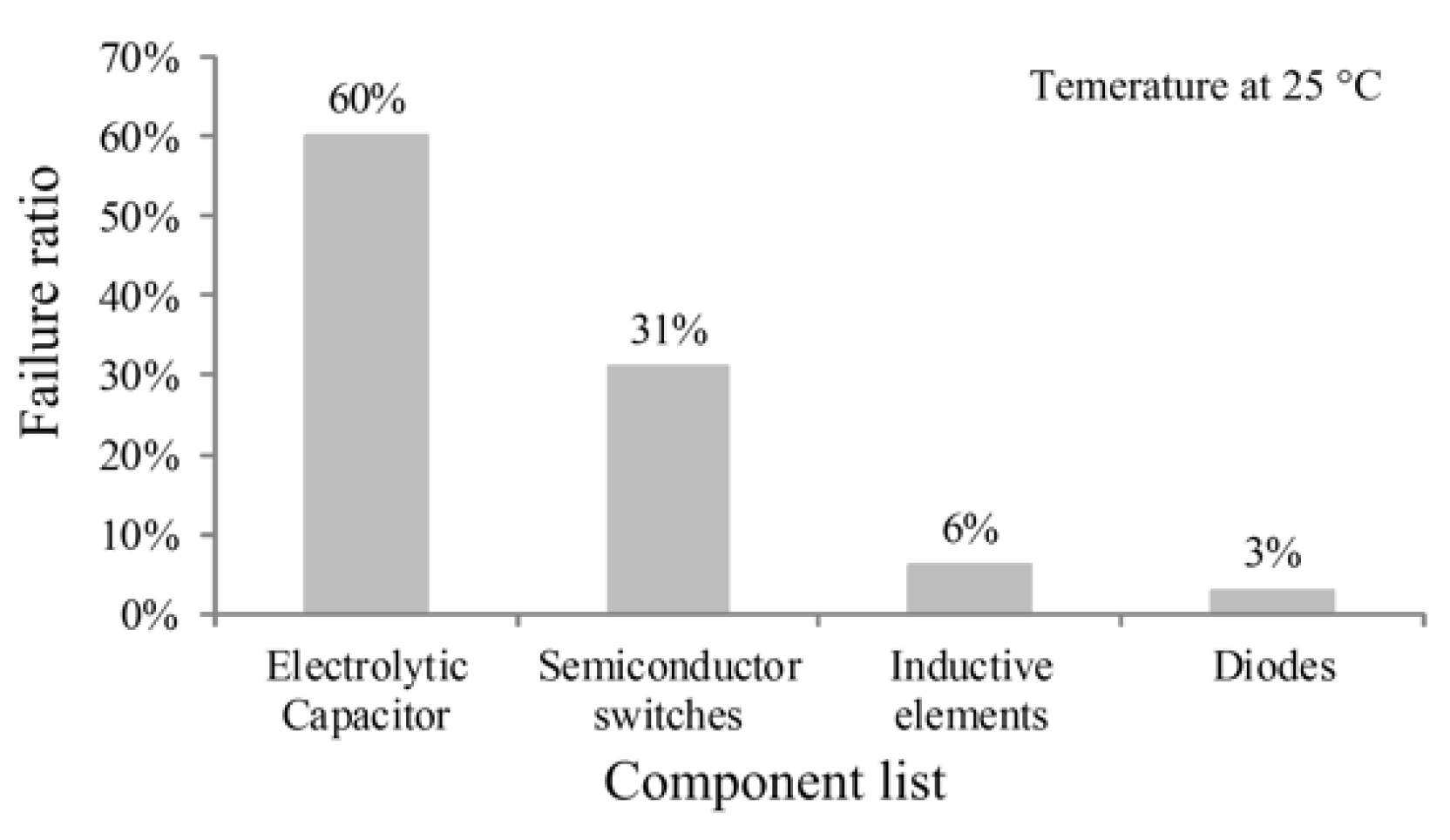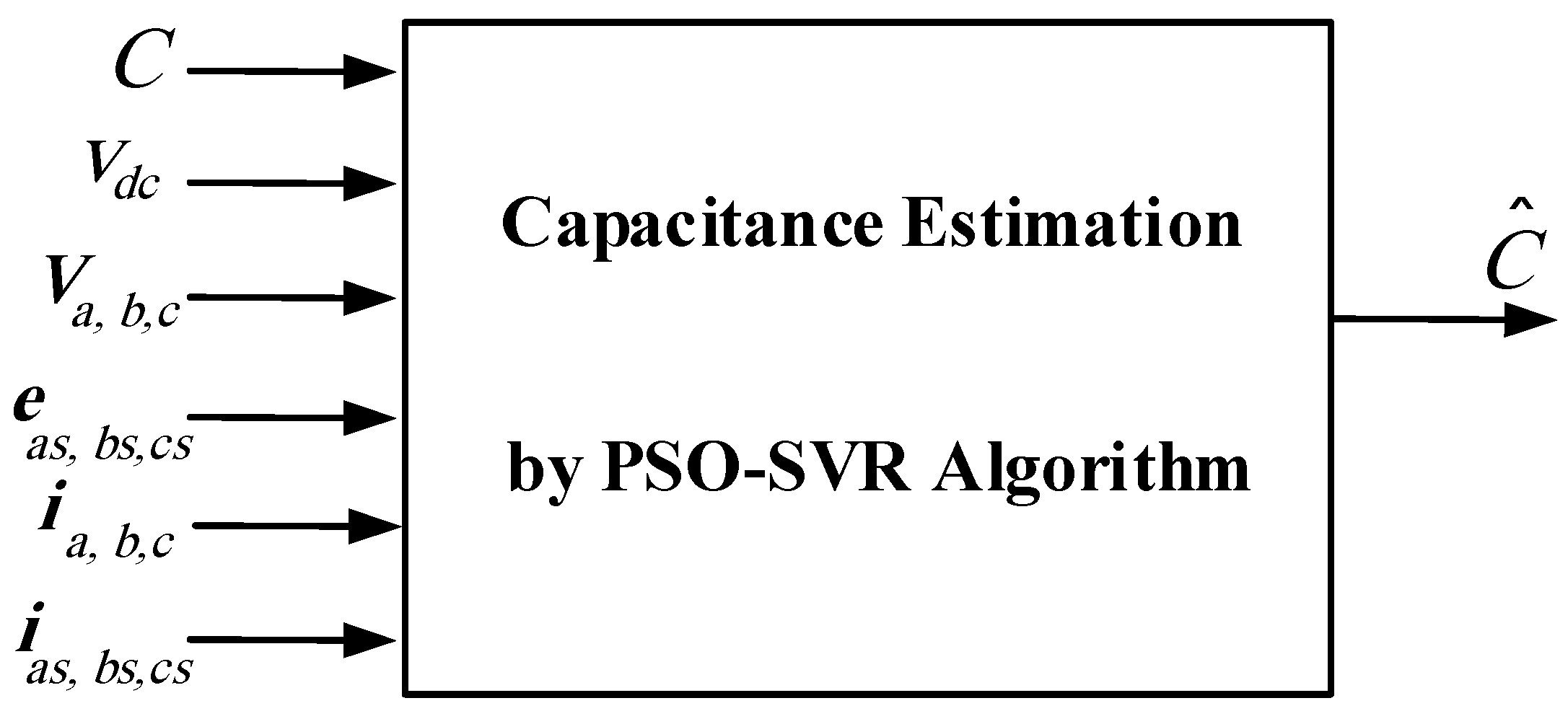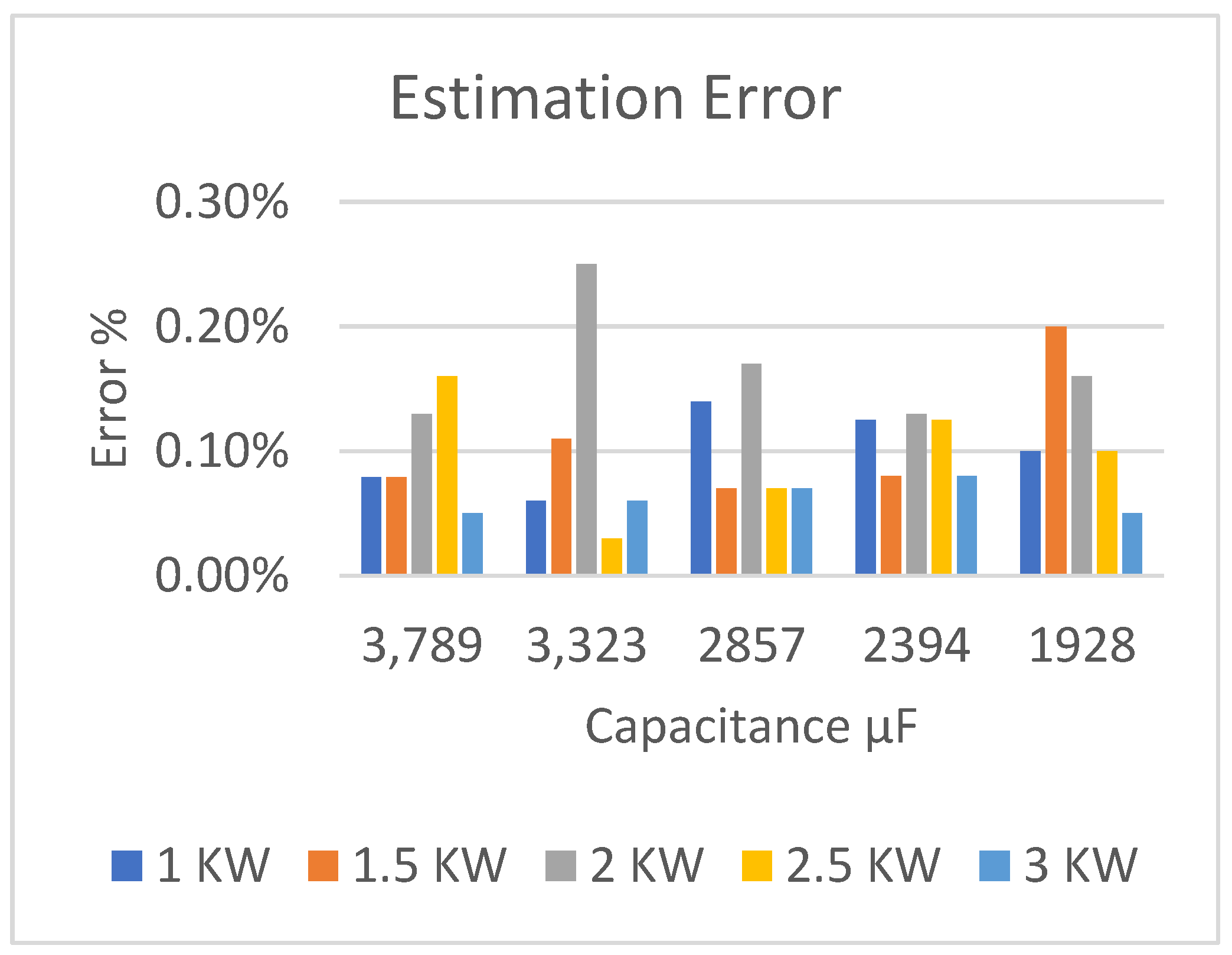Real-Time Reliability Monitoring of DC-Link Capacitors in Back-to-Back Converters
Abstract
:1. Introduction
2. Electrolytic Capacitor’s Degradation
3. PSO-SVR for Capacitor Condition Monitoring
- (1)
- Generate offline data, which are the input and output information.
- (2)
- Initialize PSO. The P0 = {P01, P02,..., P0N} are randomly set, where N is the swarm population.
- (3)
- Train SVR using each particle as SVR parameters.
- (4)
- Calculate fitness, which is the root mean square error (RMSE) between the SVR prediction and output of test data.
- (5)
- Find personal and global best positions, and update weight.
- (6)
- Repeat steps until t reaches a set maximum number.
- (7)
- SVR prediction with optimal parameters obtained by PSO.
4. Experimental Results
5. Conclusions
Author Contributions
Funding
Conflicts of Interest
References
- Yang, Y.; Kazerani, M.; Quintana, V.H. Realization of a smart electrolytic capacitor circuit. IEEE Trans. Power Electron. 2003, 18, 857–864. [Google Scholar]
- Abo-Khalil, A.G. Current Injection-Based DC-link Capacitacne Estimation Using Support Vector Regression. IET J. Power Electron. 2012, 5, 53–58. [Google Scholar] [CrossRef]
- Kieferndorf, F.D.; Forster, M.; Lipo, T.A. Reduction of DC-bus capacitor ripple current with PAM/PWM converter. IEEE Trans. Ind. Appl. 2004, 41, 781–787. [Google Scholar] [CrossRef]
- Pu, X.-S.; Nguyen, T.H.; Lee, D.-C.; Lee, K.-B.; Kim, J.-M. Fault diagnosis of DC-link capacitors in three-phase ac/dc pwm converters by online estima-tion of equivalent series resistance. IEEE Trans. Ind. Electron. 2013, 60, 4118–4127. [Google Scholar] [CrossRef]
- Harada, K.; Katuski, A.; Fujiw, M. Use of ESR for deterioration diagnosis of electrolytic capacitors. IEEE Trans. Power Electron. 1993, 8, 1199–1207. [Google Scholar] [CrossRef]
- Rendusara, D.; Cengelci, E.; Enjeti, P.; Lee, D.C. An evaluation of the DC-link capacitor heating in adjustable speed drive systems with different utility interface options. In Proceedings of the APEC ’99. Fourteenth Annual Applied Power Electronics Conference and Exposition, Dallas, TX, USA, 14–18 March 1999; Volume 2, pp. 781–787. [Google Scholar]
- Aeloiza, E.; Kim, J.-W.; Enjeti, P.; Ruminot, P. A real time method to estimate electrolytic capacitor condition in PWM adjustable speed drives and uninterruptible power supplies. In Proceedings of the 2005 IEEE 36th Power Electronics Specialists Conference, Recife, Brazil, 16 June 2005; pp. 2867–2872. [Google Scholar]
- Shoyama, M.; Deriha, F.; Ninomiya, T. Steady-state characteristics of resonance switched capacitor converters. J. Power Electron. 2005, 5, 206–212. [Google Scholar]
- Kemet Electronics, Co. Electrolytic Capacitors. Available online: http://www.kemet.com/kemet/web/homepage/kechome.nsf/weben/322E1646C60C72B285257713006ADB65/$file/F3304.pdf (accessed on 8 October 2016).
- Abo-Khalil, A.G.; Park, H.G.; Lee, D.C. Loss minimization control for doubly fed induction generators in variable speed wind turbines. In Proceedings of the IECON 2007—33rd Annual Conference of the IEEE Industrial Electronics Society, Taipei, Taiwan, 5–8 November 2007; Volume 7, pp. 1109–1114. [Google Scholar]
- Abo-Khalil, A.G.; Lee, D.C. DC-Link. Capacitance Estimation using Support Vector Regression in AC/DC/AC PWM Converters. Korean Inst. Electr. Eng. J. 2007, 56, 81–87. [Google Scholar]
- Parler, S.G., Jr. Improved Spice models of aluminum electrolytic capacitors for inverter applications. IEEE Trans. Ind. Appl. 2003, 39, 929–935. [Google Scholar] [CrossRef]
- Abo-Khalil, A.G.; Lee, D.C. DC-Link Capaciance Estimation in AC/DC/AC PWM Converters using Voltage Injection. IEEE Trans. Ind. Appl. 2008, 44, 1631–1637. [Google Scholar] [CrossRef]
- Gasperi, M.L. Life prediction modeling of bus capacitors in AC variable-frequency drives. IEEE Trans. Ind. Appl. 2005, 41, 1430–1435. [Google Scholar] [CrossRef]
- Abo-Khalil, A.G.; Lee, D.C. DC-Link Capacitance Estimation using Support Vector Regression in AC/DC/AC PWM Converters. Trans. Korean Inst. Electr. Eng. 2006, 44, 2095–2100. [Google Scholar]
- Stevens, J.; Shaffer, J.; Vandenham, J. The service life of large aluminum electrolytic capacitors: Effects of construction and application. IEEE Trans. Ind. Appl. 2002, 38, 1441–1446. [Google Scholar] [CrossRef]
- Soliman, H.; Wang, H.; Gadalla, B.; Blaabjerg, F. Condition monitoring of dc-link capacitors based on artificial neural network algorithm. In Proceedings of the 2015 IEEE 5th International Conference on Power Engineering, Energy and Electrical Drives (POWERENG), Riga, Latvia, 11–13 May 2015; pp. 1–5. [Google Scholar]
- Lee, D.-C.; Lee, K.-J.; Seok, J.-K.; Choi, J.-W. Online capacitance estimation of DC-link electrolytic capacitors of three-phase AC/DC/DC PWM converters using recursive least square method. IEE Proc. Electr. Power Appl. 2005, 152, 1503–1508. [Google Scholar] [CrossRef]
- Ma, H.; Wang, L. Fault diagnosis and failure prediction of aluminum electrolytic capacitors in power electronic converters. In Proceedings of the 31st Annual Conference of IEEE Industrial Electronics Society, 2005. IECON 2005, Raleigh, NC, USA, 6–10 November 2005; pp. 842–847. [Google Scholar]
- Sankaran, V.A.; Rees, F.L.; Avant, C.S. Electrolytic capacitor life testing and prediction. In Proceedings of the IAS ‘97. Conference Record of the 1997 IEEE Industry Applications Conference Thirty-Second IAS Annual Meeting, New Orleans, LA, USA, 5–9 October 1997; Volume 2, pp. 1058–1065. [Google Scholar]
- IEC. Fixed Capacitors for Use in Electronic Equipment—Part 4: Specification–Alumnium Electrolytic Capacitors with Solid and Non-Solid Electrolyte; International Electrotechnichal Commission: Geneva, Switzerland, 2007. [Google Scholar]
- Abo-Khalil, A.G. Impacts of Wind Farms on Power System Stability; IntecOpen: London, UK, 2013; ISBN 980-953-307-562-9. [Google Scholar]
- Abo-Khalil, A.G.; Lee, D.C. MPPT control of wind generation systems based on estimated wind speed using SVR. IEEE Trans. Ind. Electron. 2008, 55, 1489–1490. [Google Scholar] [CrossRef]
- Müller, K.R.; Smola, A.J.; Rätsch, G.; Schölkopf, B.; Kohlmorgen, J.; Vapnik, V. Predicting time series with support vector machine. In Pm/CA 1997; Springer: Berlin, Germany.
- Abo-Khalil, A.G.; Alyami, S.; Sayed, K.; Alhejji, A. Dynamic Modeling of Wind Turbines Based on Estimated Wind Speed under Turbulent Conditions. Energies 2019, 12, 1907. [Google Scholar] [CrossRef]
- Cherkassky, V.; Miller, F. Learning from Data Concepts, Theory and Methods; Wiley: Hoboken, NJ, USA, 1998. [Google Scholar]
- YU, B.G.; Abo-Khalil, A.G.; Matsui, M.; Yu, G. Support Vector Regression Based Maximum Power Point Tracking for PV Grid-Connected System. In Proceedings of the 2009 34th IEEE Photovoltaic Specialists Conference PVSC, Philadelphia, PA, USA, 7–12 June 2009. [Google Scholar]
- Abo-Khalil, A.G.; Ab-Zied, H. Sensorless Control for DFIG Wind Turbines Based on Support Vector Regression. In Proceedings of the IECON 2012—38th Annual Conference on IEEE Industrial Electronics Society, Montreal, QC, Canada, 25–28 October 2012. [Google Scholar]
- Rastgoufard, S.; Charalampidis, D. Parameter selection of multi-class SVM with evolutionary optimization methods for static security evaluation in power systems. In Proceedings of the 2016 IEEE Electrical Power and Energy Conference (EPEC), Ottawa, ON, Canada, 12–14 October 2016. [Google Scholar]
- Lee, K.; El-Sharkawi, M. Modern Heuristic Optimization Techniques; Wiley: Hoboken, NJ, USA, 2008. [Google Scholar]
- Liu, H.-H.; Chang, L.-C.; Li, C.-W.; Yang, C.-H. Particle swarm optimization-based support vector regression for tourist arrivals forecasting. Computational Intelligence and Neuroscience. Comput. Intell. Neurosci. 2018, 2018. [Google Scholar] [CrossRef] [PubMed]









| A | 3789 | 3789 | 3789 |
| B | 3323 | 3323 | 3323 |
| C | 2857 | 2857 | 2857 |
| D | 2394 | 2394 | 2394 |
| E | 1928 | 1928 | 1928 |
| Estimation Error [%] | |||
|---|---|---|---|
| by SVR | by PSOSVR | ||
| 1928 | 1925 | 1927 | 0.05 |
| 2394 | 2397 | 2391 | 0.125 |
| Parameters | Value |
| Converter power rating | 3 kVA |
| Input AC voltage | 220 V |
| Input boost inductance | 3.5 mH |
| Line resistance | 0.5 Ω |
| Switching frequency | 5 kHz |
| Injected voltage | 10 V peak, 30 Hz |
| DC-link voltage | 340 V |
| Power = 1 kW | Power = 1.5 kW | Power = 2 kW | Power = 2.5 kW | Power = 3 kW | ||||||
|---|---|---|---|---|---|---|---|---|---|---|
| Error | Error | Error | Error | Error | ||||||
| 3789 | 3786 | 0.079% | 3786 | 0.079% | 3784 | 0.13% | 3783 | 0.16% | 3787 | 0.05% |
| 3323 | 3319 | 0.06% | 3322 | 0.11% | 3319 | 0.25% | 3324 | 0.03% | 3321 | 0.06% |
| 2857 | 2853 | 0.14% | 2859 | 0.07% | 2852 | 0.17% | 2855 | 0.07% | 2855 | 0.07% |
| 2394 | 2391 | 0.125% | 2396 | 0.08% | 2392 | 0.13% | 2391 | 0.125% | 2392 | 0.08% |
| 1928 | 1926 | 0.1% | 1924 | 0.2% | 1925 | 0.16% | 1926 | 0.1% | 1927 | 0.05 |
| Power = 1 kW | Power = 1.5 kW | Power = 2 kW | Power = 2.5 kW | Power = 3 kW | Mean | Max | Min | STD | |
|---|---|---|---|---|---|---|---|---|---|
| Error | Error | Error | Error | Error | |||||
| 3789 | 0.079% | 0.079% | 0.13% | 0.16% | 0.05% | 0.000917186 | 0.16% | 0.05% | 0.000397 |
| 3323 | 0.06% | 0.11% | 0.25% | 0.03% | 0.06% | 0.001609477 | 1.00% | 0.03% | 0.004655 |
| 2857 | 0.14% | 0.07% | 0.17% | 0.07% | 0.07% | 0.000960228 | 0.17% | 0.07% | 0.000427 |
| 2394 | 0.125% | 0.08% | 0.13% | 0.125% | 0.08% | 0.001053874 | 0.13% | 0.08% | 0.000229 |
| 1928 | 0.1% | 0.2% | 0.16% | 0.1% | 0.05 | 0.002759459 | 5.00% | 0.10% | 0.019444 |
© 2019 by the authors. Licensee MDPI, Basel, Switzerland. This article is an open access article distributed under the terms and conditions of the Creative Commons Attribution (CC BY) license (http://creativecommons.org/licenses/by/4.0/).
Share and Cite
Abo-Khalil, A.G.; Alyami, S.; Alhejji, A.; Awan, A.B. Real-Time Reliability Monitoring of DC-Link Capacitors in Back-to-Back Converters. Energies 2019, 12, 2369. https://doi.org/10.3390/en12122369
Abo-Khalil AG, Alyami S, Alhejji A, Awan AB. Real-Time Reliability Monitoring of DC-Link Capacitors in Back-to-Back Converters. Energies. 2019; 12(12):2369. https://doi.org/10.3390/en12122369
Chicago/Turabian StyleAbo-Khalil, Ahmed G., Saeed Alyami, Ayman Alhejji, and Ahmed B. Awan. 2019. "Real-Time Reliability Monitoring of DC-Link Capacitors in Back-to-Back Converters" Energies 12, no. 12: 2369. https://doi.org/10.3390/en12122369





